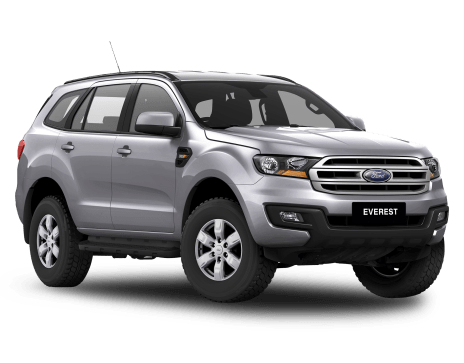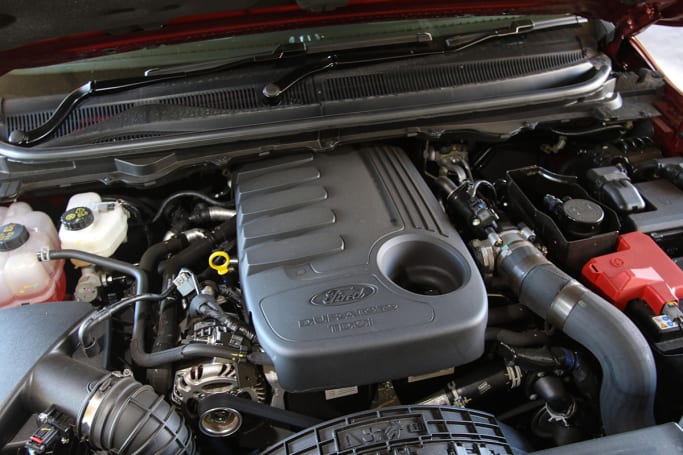
Isuzu MU-X 2017 review
Look out Fortuner and Everest. Isuzu has just updated the MU-X for the second time this year, with an exterior facelift and a smarten-up of the interior atop the new drivetrain it scored in February.
Browse over 9,000 car reviews
Ford previewed the Ranger-based Everest several years ago at a big, flashy function in Sydney where it predicted the rugged wagon category was set to take off in Australia.
At the same time, it was orchestrating the end of its popular and very clever Ford Territory SUV, as well as lining up a range of imported products to fill out its SUV ranks.
Based on the Ranger pickup truck platform, the Everest launched in 2015 to much fanfare - and with relatively high prices. It is considerably different to the Ranger in execution and appointments - but is it sufficiently different to warrant its extra cost?
| Ford Everest 2017: Trend (rwd) | |
|---|---|
| Safety rating | |
| Engine Type | 3.2L turbo |
| Fuel Type | Diesel |
| Fuel Efficiency | 8.4L/100km |
| Seating | 7 seats |
| Price from | $40,590 |
Ford has deliberately moved the Everest away from the boxy, utilitarian design of the Ranger. As a result, it's much softer with more subtle curves, although the overuse of large, chrome elements on the nose reflects more on American trends rather than Aussie tastes, and may not sit especially well in a relatively conservative Australian car park.
Visually, it appears shorter than the Ranger, thanks to minimal front and rear overhangs which helps its off-road performance. The numbers confirm this, too, with the Everest some 370mm shorter in its wheelbase and 470mm shorter overall. On looks alone, it's undoubtedly a rough and tough off-road toy.
The interior also pushes away from that of the donor Ranger. More stylish and car-like trim pieces including a different dash with a soft top, padded centre bin console cover, and padded armrests support the Everest's more civilian intentions.

The Everest is very generously sized, which means three people can sit across the middle row with ease. There are two ISOFIX child restraint mounts for the outside pair of second-row seats, and there's also plenty of headroom for even the tallest passengers.
The cloth seats are deep and comfortable, though they are a little lacking in side bolster padding. There is a USB point under the centre console along with two 12 volt power points and a multimedia touchscreen system that runs Ford's own Sync 3 system.
Sync 3, despite promising class-leading voice activation, offers anything but, with a frustratingly poor performance on even the most fundamental of instructions. It does offer compatibility with Apple Carplay and Android Auto., although the latter - as with most applications - is much less intuitive than the Apple app.
There are plenty of places to stash bottles within the Everest including twin bottle holders in each of the doors, a pair of cup holders in the front centre, as well as in the centre in the second row middle and cup holders for the third row of seats.
There is also a 240 volt power socket next to a 12 volt socket with a set of climate controls for the second row of seats.
Speaking of the third row, the two seats are reasonably sized, while the middle row folds forward easily to allow relatively easy access. Again, it's not a space for a bigger human, but it is larger than some of its rivals, including the Pajero Sport.
The third row of seats folds down quickly and easily to reveal a large cargo space of 1050 litres, although the prominent wheelarches of the rear end of the Everest do get in the way a little bit for awkward sized loads. Folding all seats down increases this volume to 2010 litres.
We have to take some marks off for the poor design of the seat belt mountings. When the middle and rear seats are folded, it's too easy to ensnare the outer seat belt in the seat fold, which means you have to undo the seat again to retrieve it.
Visibility is excellent. The C-pillars are not overly thick and there is a large glass porthole in the rear three-quarter. The Trend doesn't come with tinted glass; while it heats up the cabin, it does also mean you have a clearer view.
All windows in the Trend feature automatic power-up, while many of the car's systems and menus have been moved to the touchscreen system, including climate, phone, and satellite navigation.
The instrument binnacle runs just an analogue speedometer with a digital rev counter buried in the options of the small right hand digital screen. There is a left hand screen, which is used to scroll through options like entertainment and multimedia.
The right screen also features a digital speedo, which is a welcome addition.
The Trend comes very well equipped with extras like radar cruise control, lane departure assistance and auto emergency brake. There are also automatic headlights and wipers, the aforementioned Sync 3 multimedia system that uses an 8.0-inch touchscreen, LED lighting throughout the car and a powered tailgate.
The Everest, though, started at a high retail price and, despite some recent adjustments, hasn't moved too far south from there; priced at $55,990 until April this year, even its new $53,990 ticket before on-roads is already dearer than most of its competition, before you realise those competitors (like Mitsubishi's Pajero Sport GLS ($48,500 in auto), the Isuzu MU-X LS-U ($49,000 in auto), and Holden's Trailblazer) are cheaper even in 4x4 guise.
When compared to a 4x2 rival like the Isuzu, it looks even worse. The MU-X costs around $7000 less even in its top spec LS-T form at $47,500; like for like, it's more than $9,000 cheaper in LS-U spec.
The Everest uses the same 3.2-litre five-cylinder turbocharged diesel engine as the Ranger, though different emissions gear means that while it retains the same torque figure of 470Nm, it drops 4kW over the Ranger to post a peak power figure of 143kW.
The Trend can tow 3000kg in 4x2 form, which is pretty handy for small- to medium-sized caravans and boats.
All Everest variants run a six-speed automatic transmission, and in the case of the Trend RWD (rear-wheel drive), all power is sent to the rear end.
The Trend can tow 3000kg in 4x2 form, which is pretty handy for small- to medium-sized caravans and boats. At 595kg of payload, though, it can carry the least gear of all the Everest range; almost 100kg less than the Trend AWD and more than 130kg less than the base spec Ambiente AWD.

Over a test length of 280 kilometres with mixed condition driving, we recorded a dash indicated fuel economy figure of 11.3 litres per 100 kilometres.
This compares with a rated fuel consumption figure of 8.4L/100km. A large 80-litre tank gives the Everest a theoretical touring range of 950km.
The biggest mechanical change between the Everest and the Ranger is also the one that provides the most difference out on the road. Instead of long leaf springs, designed to better carry heavy payloads, the Everest uses coil springs in the rear to give it a much more forgiving, car-like ride.
The steering, too, is surprisingly light and easy to use for such a big car.
There's no hiding, though, that it's well over 2.2 tonnes of truck out on the open road. The ride is soft and very supple over all surfaces, but thankfully it doesn't easily degenerate into body roll. Of course, it's not meant to be hurled around corners like a sports car, either, so driving it to spec is the easiest way to get the best from it.
With 225mm of ground clearance and short front and rear overhangs, the Everest has off-road chops, but lacks the outright ability of its better equipped 4x4 brethren.
As far as the difference between a 4x2 and 4x4 on the road, the rear-drive Everest has slightly lighter steering, but really, that's about it.
With 225mm of ground clearance and short front and rear overhangs, the Everest has off-road chops, but lacks the outright ability of its better equipped 4x4 brethren. An open diff, rear-wheel drive and no terrain management means you'll be relying more on your skills and experience to get into the bush – and back again.
A limited run on a mixed gravel road reveals a truck with excellent cruising abilities over unsealed surfaces, thanks to that softer, more pliant coil-sprung ride.
Extra sound deadening and a clever noise attenuation system built into the audio system (think 'noise cancelling headphones') keeps the cabin quieter than the Ranger, although the large door mirrors generate some wind noise at highway speeds – and you'll never mistake the fact that a diesel engine resides under the bonnet.
Basic Warranty
3 years / 100,000 km warranty
ANCAP Safety Rating

Seven airbags – including full length curtain bags – AEB, lane keeping assistance, a rear view camera and sensors, adaptive cruise control, trailer sway control, and front collision warning all contribute to a five-from-five ANCAP safety rating for the Everest Trend.
Blind-spot detection is kept for the top grade cars only, though.
The Everest is covered a three-year/100,000km warranty, while servicing is recommended every 15,000km or 12 months.
The price of the first service is capped at $390, the second at $520, and the third is $480. It then rises to $520, before falling back to $390 for the five year service.
Interestingly, the Ford website calculates the service prices out to 33 years!
While the three-year warranty period is in line with its direct competitors, longer warranties are becoming the norm for the industry.
The Everest and the Territory actually don't have all that much in common aside from a flexible, practical interior and seven seats; the Everest's underpinnings and gruff diesel engine see to that.
If towing ability, off-road talent and on-road comfort are priorities, though, then the Everest is a good device for a Ford fan willing to pay a premium.
The Everest's biggest obstacle to success, though, is a recommended retail price that is too far above those of its key competitors.
| Vehicle | Specs | Price* | |
|---|---|---|---|
| Ambiente | 3.2L, Diesel, 6 SP AUTO | No recent listings | 2017 Ford Everest 2017 Ambiente Pricing and Specs |
| Trend | 3.2L, Diesel, 6 SP AUTO | No recent listings | 2017 Ford Everest 2017 Trend Pricing and Specs |
| Titanium | 3.2L, Diesel, 6 SP AUTO | No recent listings | 2017 Ford Everest 2017 Titanium Pricing and Specs |
| Trend (rwd) | 3.2L, Diesel, 6 SP AUTO | $42,570 – 49,500 | 2017 Ford Everest 2017 Trend (rwd) Pricing and Specs |
| Design | 7 |
|---|---|
| Practicality | 8 |
| Price and features | 6 |
| Under the bonnet | 7 |
| Efficiency | 7 |
| Driving | 7 |
| Safety | 8 |
| Ownership | 7 |
$24,998
Lowest price, based on 120 car listings in the last 6 months